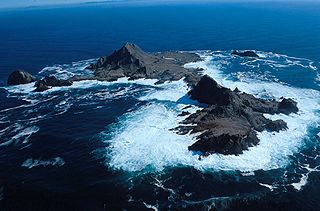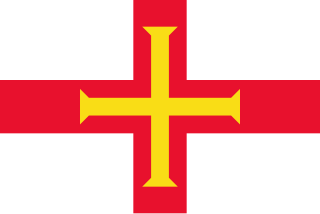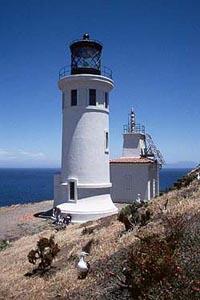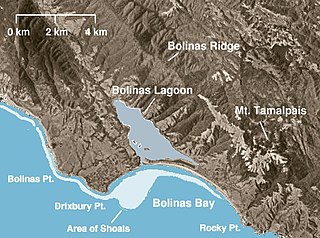The Chumash are a Native American people who historically inhabited the central and southern coastal regions of California, in portions of what is now San Luis Obispo, Santa Barbara, Ventura and Los Angeles counties, extending from Morro Bay in the north to Malibu in the south. They also occupied three of the Channel Islands: Santa Cruz, Santa Rosa, and San Miguel; the smaller island of Anacapa was likely inhabited seasonally due to the lack of a consistent water source.

Anacapa Island is a small volcanic island located about 11 miles (18 km) off the coast of Port Hueneme, California, in Ventura County. The island is composed of a series of narrow islets 6 mi (10 km) long, oriented generally east-west and 5 mi (8 km) east of Santa Cruz Island. The three main islets, East, Middle and West Anacapa, are collectively known as The Anacapas by some authors. All three islets have precipitous cliffs, dropping off steeply into the sea.

The island fox is a small fox that is native to six of the eight Channel Islands of California. There are six subspecies, each unique to the island it lives on, reflecting its evolutionary history. Island foxes are generally docile, show little fear of humans, and are easily tamed. Island foxes played an important role in the spiritual lives of native Channel Islanders. Island foxes have been likely semi-domesticated as pets, used as pelts, or for other functions like pest control.

Santa Cruz Island is the largest of the eight islands in the Channel Islands and also the largest island in California, located off the coast of California. The island, in the northern group of the Channel Islands, is 22 miles (35 km) long and from 2 to 6 miles wide with an area of 61,764.6 acres (249.952 km2). Santa Cruz Island is located within Santa Barbara County, California. The coastline has steep cliffs, gigantic sea caves, coves, and sandy beaches. Defined by the United States Census Bureau as Block 3000, Block Group 3, Census Tract 29.10 of Santa Barbara County, the 2000 census showed an official population of two persons. The highest peak is Devils Peak, at 2450+ feet. It was the largest privately owned island off the continental United States but is currently jointly owned by the National Park Service (24%), and the Nature Conservancy (76%).

Santa Barbara Island is a small island of the Channel Islands archipelago in Southern California. It is protected within Channel Islands National Park, and its marine ecosystem is part of the Channel Islands National Marine Sanctuary.

Santa Rosa Island is the second largest of the Channel Islands of California at 53,195 acres. Santa Rosa is located about 26 miles (42 km) off the coast of Santa Barbara, California in Santa Barbara County and is part of Channel Islands National Park.

The island scrub jay also island jay or Santa Cruz jay is a bird in the scrub jay genus, Aphelocoma, which is endemic to Santa Cruz Island off the coast of Southern California. Of the over 500 breeding bird species in the continental U.S. and Canada, it is the only insular endemic landbird species. The island scrub jay (ISSJ) is closely related to the California scrub jay – the coastal population found on the adjacent mainland – but differs in being larger, more brightly colored, and having a markedly stouter bill. The large bill size is related to its diet, incorporating the thick-shelled acorns of the island oak. They will bury, or cache, the acorns in the fall and may eat them months later. They also eat insects, spiders, snakes, lizards, mice and other birds' eggs and nestlings.

The Farallon Islands, or Farallones, are a group of islands and sea stacks in the Gulf of the Farallones, off the coast of San Francisco, California, United States. The islands are also sometimes referred to by mariners as the Devil's Teeth Islands, in reference to the many treacherous underwater shoals in their vicinity. The islands lie 30 miles (48 km) outside the Golden Gate and 20 miles (32 km) south of Point Reyes, and are visible from the mainland on clear days. The islands are part of the City and County of San Francisco. The only inhabited portion of the islands is on Southeast Farallon Island (SEFI), where researchers from Point Blue Conservation Science and the U.S. Fish and Wildlife Service stay. The islands are closed to the public.

The culture of Guernsey in the Bailiwick of Guernsey is a culture which has been shaped by its indigenous Norman language and traditions as well as French and British cultural influences. Cultural trends from immigrant communities such as the Portuguese have also been added.

Anacapa Island Lighthouse is a lighthouse in California, United States, on the entrance to Santa Barbara Channel, California. Constructed in 1912, it was the last major light station built on the west coast. Anacapa and several other islands were collectively designated as Channel Islands National Monument in 1938, though the Coast Guard retained responsibility for the Anacapa lighthouse. Now fully automated and unmanned, the light house still operates, but the National Park Service (NPS) is responsible for Channel Islands National Park.

A surge channel is a narrow inlet, usually on a rocky shoreline, and is formed by differential erosion of those rocks by coastal wave action. As waves strike the shore, water fills the channel, and drains out again as the waves retreat. The narrow confines of the channel create powerful currents that reverse themselves rapidly as the water level rises and falls, and cause violent hydrodynamic mixing. However, there is relatively little exchange of water between channels; experimental studies and mathematical modelling of the coastline near Hopkins Marine Station in California have shown that water is rapidly mixed within each channel, but that it mostly moves in an oscillatory manner. Surge channels have been likened to 'containment vessels', retaining water borne gametes and probably enhancing the effectiveness of external fertilisation of marine species dwelling within them.
Marathon swimming is a class of open water swimming defined by long distances and traditional rules based in English Channel swimming. Unlike marathon foot-races which have a specifically defined distance, marathon swims vary in distance. However, one commonly used minimum definition is 10 kilometers, the distance of the marathon swimming event at the Olympic Games.

Del Mar Landing State Marine Reserve (SMR) is a marine protected area that lies onshore, about two miles south of the town of Gualala and three and a half miles north of Sea Ranch in Sonoma County on California’s north central coast. The marine protected area covers 0.22 square miles (0.57 km2). Del Mar Landing SMR prohibits the take of all living marine resources.

Duxbury Reef State Marine Conservation Area (SMCA) is a marine protected area located about 1 mile (2 km) west of Bolinas in Marin County on California’s north central coast. This marine protected area covers 0.66 square miles (1.7 km2). Duxbury Reef SMCA prohibits the take of all living marine resources, except the recreational take of finfish from shore only and the recreational take of abalone.

Cartoon Network Russia and Southeastern Europe is a pay-television kids channel that was launched on 1 October 2009, replacing the Pan-European feed of Cartoon Network. It is available in Russian, Bulgarian and English. Both feeds are the same, except for local advertisements. The Russian website launched in October 2010. Cartoon Network doesn't have its own English site, but uses the Pan-European Cartoon Network's site. On 26 November 2010 the channel changed its look and logo. In March 2011 the CIS feed was 24 hours. On 1 January 2014 all feeds of the channels became 24 hours.















